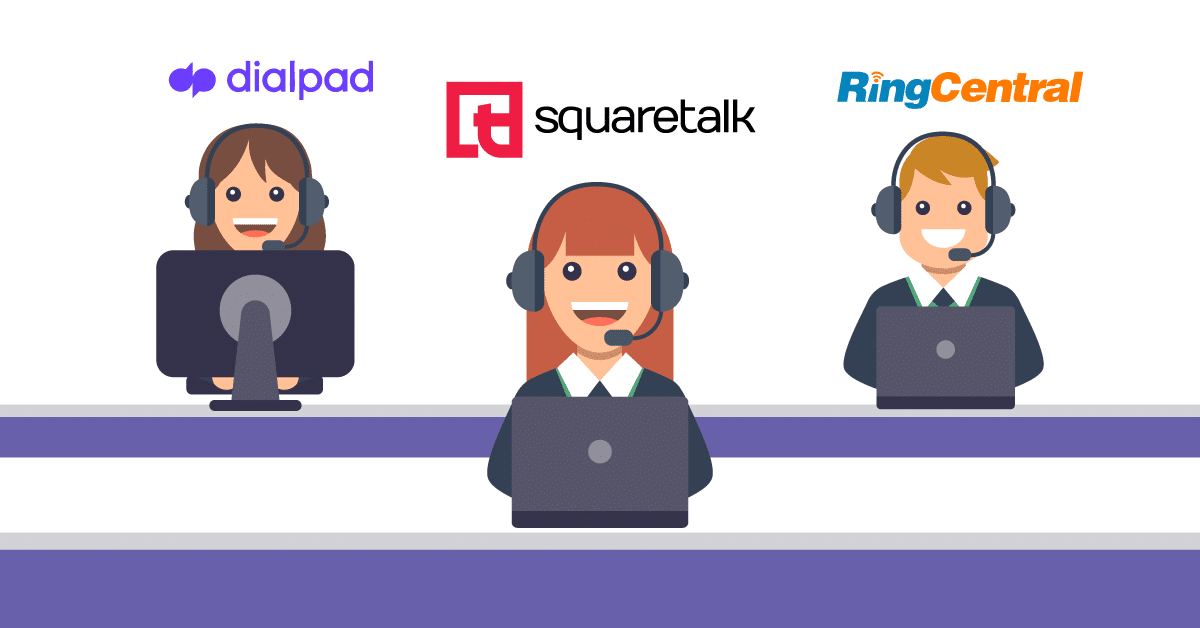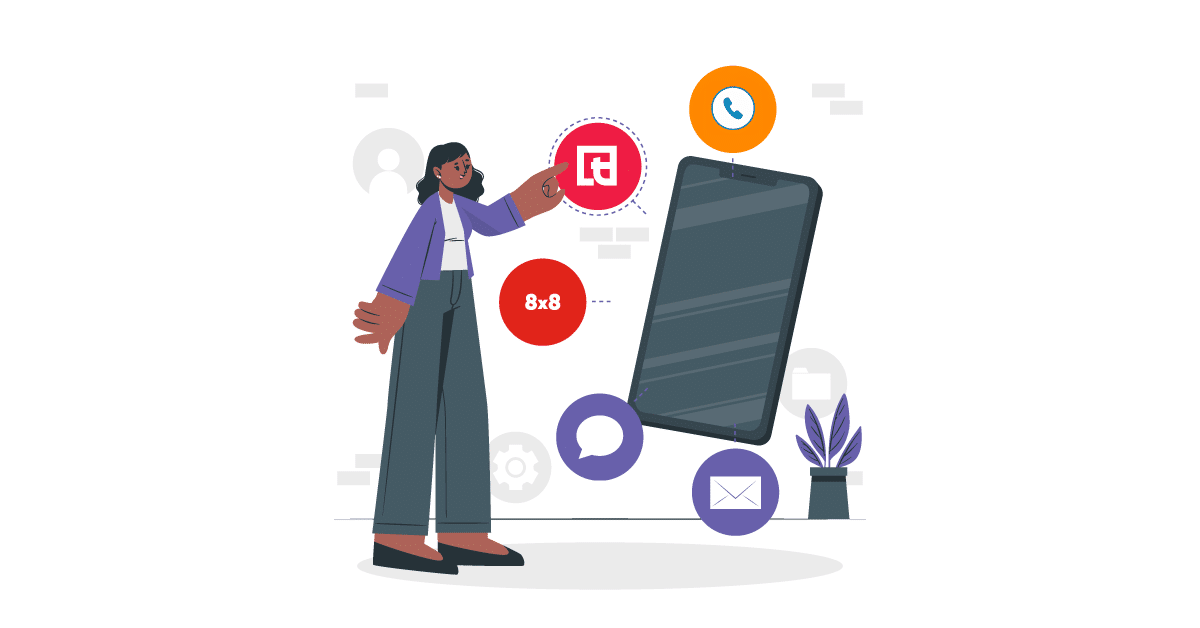You may not know this, but your most recent professional call was probably done over the internet. Voice over Internet Protocol (VoIP) communication has been around for around two decades and it’s on the rise.
In fact, the 2032 value projection of the VoIP industry is expected to reach $100 billion. That’s no small feat for such a young yet burgeoning industry. With this in mind, business owners and leaders who are looking to see how VoIP is set to make waves in the field of professional communication will be well-positioned to explore the key VoIP trends covered below.
So, without further ado, let’s take a closer look.
What is VoIP?
In brief, VoIP is a method of communication, introduced around 2004, carried out through technology. However, instead of using landlines, it uses a person’s broadband to place and receive calls. It’s estimated that adopt a VoIP system can save 32 minutes of calls per day per team member due to better agent availability, more flexibility and features that automate routine tasks.
You need only a PC, laptop, or smart device, a router, and a headset for calls that transmit speech through an internet connection. This simplifies business calls and keeps communication costs low. In fact, a business can save between 30% and 50% on avarage.
Key VoIP Trends to Watch in 2024
With VoIP set to continue making waves in the business space, let’s explore some of the cutting-edge trends that are expected to come to fruition this year.
AI and Hosted VoIP Phone Features
Artificial intelligence (AI) tools and technologies are rapidly gaining momentum in many business spheres. Examples include using generative AI, machine learning, robotics, and other tools in marketing, administrative tasks, brand logo design, content generation, data management, and more.
So, is there a way AI can be incorporated into VoIP solutions? The answer is yes. Such technologies will enhance VoIP services in a myriad of ways, among which include:
- Speech recognition
- Call routing and predictive dialing
- Customer service interactions
- Conversational agents
- Virtual assistants
- Chatbots
- Speech-to-text conversions
- Adaptability to varied accents/dialects
In fact, it’s predicted that AI will power 95% of all customer interactions by next year alone.
By partnering with leading business VoIP providers, you can integrate AI-driven features into your communication system to significantly boost customer engagement and streamline your operations.
Ultimately, if you run a business that has a large database of customers and you want to be available to them via calls, while ensuring that they have a smooth customer journey, VoIP with the aid of artificial intelligence will come in as a highly useful helper.
Whether it’s through AI-powered voice assistants or business software apps that understand natural language while responding to user requests, reliability is paramount and it is expected to take center stage.
Hybrid Work Models
Although the Covid-19 pandemic is now behind us, some remnants of its impact remain entrenched in the business world. We are talking about the continued rise of remote work.
What this means is that there’s an ever growing number of distributed global teams that need to communicate with one another quickly, with no lags, and smoothly. In fact, there was a 212% rise in VoIP usage in 2020 alone and around 35% of employees use remote work models.
VoIP’s integrations with collaboration tools and advanced call routing will continue to see heightened usage among dispersed teams for greater communication efficiencies in 2024.

Mobility, Mobile Apps, and Mobile Unified Communications
There is consensus among many experts that mobile phones and smart devises will soon become the centerpiece of a company’s application ecosystem.
In terms of mobile unified communications (UC), with the rise in remote work and the high proliferation of smartphones, it’s only natural that Voice over IP services will start extending to mobile devices.
This means that irrespective of location, remote teams can take advantage of internet communication while experiencing great boosts in productivity. Appearing in the form of mobile VoIP (mVoIP) solutions, it will be possible to communicate and collaborate with customers and colleagues smartly.
This market is poised for significant growth in the near future, as predictions indicate a compound annual growth rate of an impressive 16.8% from 2019 to 2025. This is largely driven by the fact that around 80% of employees use their mobile devices for professional purposes and work-related communication. In addition, it’s been reported that 74% of employees use VoIP apps on mobile devices for daily business calls, and in 2024, these numbers are sure to increase.
5G networks
The rollout of 5G networks is expected to change VoIP services for the better and facilitate mVoIP solution.
We expect to see more sophisticated VoIP apps, which ultimately help users make better quality calls and even instant messaging, on the move, with faster data speeds and reduced latency.
This applies to all types of teams, from in-office and hybrid to distributed remote teams.
UCaaS
Unified Communications-as-a-Service (UCaaS) takes a whole spectrum of communication and brings them together.
Think phone services, messaging, video conferencing, document sharing, screen sharing, email integration, etc. in a single platform.
Ideal for a hybrid work environment, it introduces cost savings, security and compliance, centralized management, and a better customer experience while allowing for scalability and flexibility.
In addition, many UCaaS platforms now integrate advanced contact center software solutions to further streamline customer interactions.
A research shows that the unified communications market will grow at a 17.4% CAGR from 2023 to 2030 worldwide. The illustrates the evolution of VoIP and the shift many businesses will make from using only voice services to integrated communication platforms.
WebRTC and VoIP integration
Another critical area where VoIP will play an essential role is in WebRTC or web real-time communication. Through this technology, users can make calls through a web-based application. A VoIP platform, for example, can be directly accessed from the web, which takes away the need to download any additional software. It also offers a type of “VoIP dashboard”, which enable users to carry out multiple tasks, including:
- Make and receive calls
- Purchase new phone numbers
- Set up auto-attendants
- Set up weekly schedules
- Choose actions based on potential calls
- Monitor and listen to call recordings
- Monitor and track expenditure balance
The integration of VoIP with WebRTC can help business teams collaborate across any device or location that has internet connectivity. Apart from this enhanced accessibility and cross-platform compatibility, it will also offer simplified development and management, cost-effective solutions, communication security, and more.
In addition, using a Windows or Linux server allows more control over all the integrations and access to important data, which can be really helpful for customer analytics and many other tasks.
Security
With the growth of a broad range of call center cybersecurity threats, such as distributed denial-of-service (DDoS) attacks, call hijackings, network intrusion, eavesdropping, leaks, hacking, and service threats, among others, security will become paramount for VoIP service providers and businesses alike. On average, data breaches in the US cost around $8.64 million. For this reason, many measures are being put into place to protect users and businesses from these dangers, including:
- Encryption-Based Privacy
- Regular Updates
- User Authentication
- Network Security
- Threat Detection
- Data Leak Prevention
- Secure voice over VPN
- Multi-Factor Authentication
Through a combination of these strategies, VoIP service providers will keep offering more robust security protection, while ensuring that businesses can concentrate on their core competencies.

Sustainability
Sustainability is also a major driving force and rising trend. That’s why green VoIP technologies are quickly becoming a go-to solution for many companies.
They can not only help reduce businesses’ carbon footprints but also lead to cost savings.
In 2024, more businesses are predicted to:
- Use energy-efficient IP phones, routers and other networking equipment
- Utilize data centers with advanced cooling systems, renewable energy sources and optimized server hardware
- Rely on cloud-based VoIP
- Consolidate multiple VoIP servers onto fewer physical machines to reduce the overall hardware footprint
- Reduce the need for physical interventions and associated travel emissions with tools for remote management and monitoring of VoIP systems
- Encourage the use of digital communications over traditional paper-based systems
IoT integration
Internet of Things (IoT) devices are also expected to shape the future of VoIP technology, while enhancing collaboration and boosting productivity.
Whether it’s communicating through smart speakers, smart home devices, wearables, connected vehicles, etc., the shift is going to see improvements in:
- Operational Efficiency
- Access to Real-Time Monitoring and Insights
- An Enhanced Customer Experience
- Better Remote Management
- And more.
The Future of VoIP: Supporting Business Communication
With all of VoIP’s current advantages in mind, it’s critical to consider how business communication will be enhanced in the future. The impacts of AI, mobile apps, the increased availability and use of 5G networks, and other developments will surely impact the way professional teams communicate internally and with their customers. Speed, efficiency, and convenience will be driving forces behind these changes.
Security will continue to remain a prominent feature of the business communication space, as hackers become increasingly sophisticated in their attacks.
And naturally, with sustainability driving many consumer purchasing decisions, businesses that focus on adopting green technologies are expected to have a stronger competitive advantage.
Lastly, with the interconnectivity of devices, IoT and VoIP will continue to see heightened integrations as businesses progressively move to omnichannel solutions that they can help them provide greater flexibility and levels of convenience to their customers.
Final thoughts
Whether you’re looking to cut costs, create a greater customer experience, or future-proof your business, VoIP is a practical solution. Keeping up with trends and innovations is the best way to utilize this technology’s full potential, adapt, and gain a competitive advantage.

Velislava Georgieva
Velislava Georgieva is an Outreach and Content Manager at Inbound Blogging, specializing in Content Marketing and Outreach Strategies. Besides her passion for digital marketing, she likes yoga, fitness, and hiking. You can connect with her on LinkedIn.






